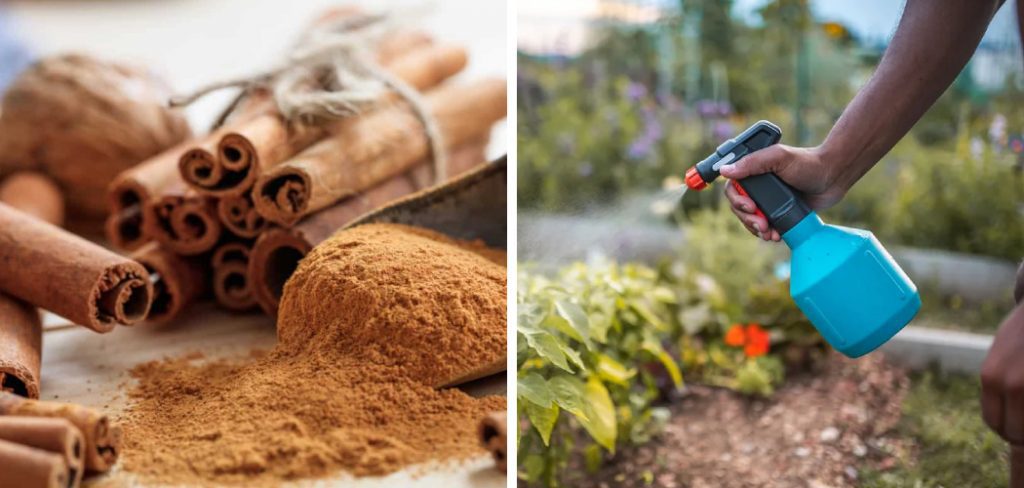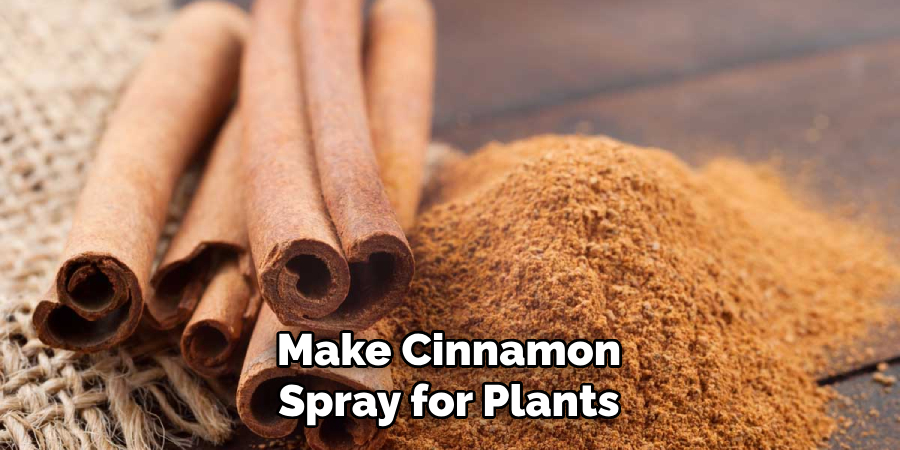To make cinnamon spray for plants, combine 1 teaspoon of cinnamon oil with 4 cups of water. Cinnamon spray can be used as a natural fungicide and insect repellent for your plants.
It is safe to use and can help prevent diseases and pests from damaging your plants, making it a great option for organic gardening. Using cinnamon spray regularly can promote healthier growth and protect your plants from various issues. Additionally, it is easy to make at home and can be applied to both indoor and outdoor plants.
So, give your plants a boost with the power of cinnamon spray.

Benefits Of Using Cinnamon Spray For Plants
Cinnamon spray for plants offers multiple benefits, including natural pest control, fungal disease prevention, and increased plant growth and resistance. By using this homemade spray, you can protect your plants from harmful pests without resorting to harsh chemicals. The antimicrobial properties of cinnamon help to ward off insects and other pests that could damage your plants.
Additionally, cinnamon spray acts as a natural fungicide, reducing the risk of fungal diseases that can spread rapidly. Furthermore, this spray promotes healthier plant growth and increases their ability to resist environmental stressors. By incorporating this simple and cost-effective solution into your garden routine, you can enjoy more vibrant and thriving plants that are protected from pests and diseases.
How Cinnamon Spray Works For Plants
Cinnamon spray works wonders for plants due to its antifungal properties and insect repellent action. Its natural compounds help prevent the growth of harmful fungi and protect plants from fungal diseases. Additionally, cinnamon spray acts as an effective insect repellent, keeping away pests like ants, gnats, and flies.
By creating a barrier around your plants, it deters these unwanted visitors and promotes healthier growth. To make cinnamon spray, simply mix one tablespoon of cinnamon powder with four cups of water. Allow the mixture to steep overnight, then strain it into a spray bottle.
Spritz the solution onto your plants, focusing on the leaves and stems. Regular application will help safeguard your plants from fungal infections and keep insects at bay. Enjoy the benefits of this homemade remedy for your garden!
How to Make Cinnamon Spray for Plants: Step by Step Guide
Making Your Own Cinnamon Spray
Gather all the necessary ingredients to make your own cinnamon spray for plants. Once you have everything ready, prepare the cinnamon solution by mixing the required measurements. You can choose from various application methods like spraying or directly applying the solution to the affected areas.
Experiment with different techniques to find the one that works best for your plants. This natural remedy can help protect your plants from pests and diseases without needing to rely on harmful chemicals. Making your own cinnamon spray is an eco-friendly and cost-effective way to give your plants the care they deserve.
So go ahead and start creating your homemade solution today to keep your plants healthy and thriving.
Ingredient Gathering
To make cinnamon spray for plants, you’ll need either cinnamon powder or cinnamon sticks. Gather them, along with water and a spray bottle. Mix the cinnamon with water in the spray bottle. Shake it well to ensure the cinnamon is properly infused.
Allow the mixture to sit for a day or two. Afterward, spray the cinnamon solution on your plants to deter pests and promote growth. Remember to apply the spray evenly, covering both sides of the leaves. This natural remedy can be used on a variety of plants, including flowers, herbs, and vegetables.
By using cinnamon spray regularly, you can keep your plants healthy and protected.
Preparing The Cinnamon Solution
Preparing the cinnamon solution is a crucial step in making a homemade cinnamon spray for plants. Choosing the right type of cinnamon is essential to ensure its effectiveness. Mixing cinnamon with water creates a potent solution that can benefit your plants.
The combination helps to prevent pests and fungal diseases and promotes healthy growth. Cinnamon contains natural anti-fungal and anti-bacterial properties that can protect your plants from various issues. It is important to dilute the cinnamon properly to ensure it does not harm the plants.
By following these steps, you can easily make a cinnamon spray that is safe for your plants and environmentally friendly. Keep in mind to apply the spray regularly for optimal results in protecting and enhancing the health of your plants.
Application Methods
Cinnamon spray is a popular method for protecting plants from pests and diseases. One way to apply it is through foliar spray, where the solution is sprayed directly onto the leaves. This allows the plant to absorb the cinnamon and its beneficial properties.
Another method is soil drench, where the cinnamon solution is poured directly onto the soil around the plant’s roots. This allows the roots to absorb the cinnamon and distribute it throughout the plant. Both methods are effective in deterring pests and preventing fungal infections.
Remember to dilute the cinnamon in water and test it on a small area of your plants before applying it to the entire plant. Regular application can help keep your plants healthy and thriving.
Tips For Using Cinnamon Spray Effectively
To effectively use cinnamon spray for plants, it is crucial to consider the timing of applications. Applying it early in the morning or late in the evening ensures maximum absorption. Dilution ratios must be properly followed to avoid any harm to the plants.
Achieving a balanced mixture will yield optimal results. Reapplication frequency is also important to maintain a consistent protective barrier against pests and diseases. Regular spraying every 7-10 days is recommended, especially during periods of high infestation or disease pressure. By adhering to these guidelines, you can harness the natural power of cinnamon to keep your plants healthy and thriving.
Frequently Asked Questions For How To Make Cinnamon Spray For Plants
How Do You Make Cinnamon Spray For Plants?

To make cinnamon spray for plants, mix 2 tablespoons of cinnamon powder with 1 quart of water. Allow the mixture to sit overnight, then strain it to remove any sediment before pouring it into a spray bottle. Use the spray to protect your plants from pests or fungal diseases.
Can Cinnamon Spray Help With Plant Growth?
While cinnamon spray is primarily used for pest control, some gardeners believe that it can also promote plant growth. Cinnamon contains natural compounds that may stimulate root development and protect against certain plant diseases. However, scientific evidence for its effectiveness as a growth stimulant is limited.
Is Cinnamon Spray Safe For All Plants?
Cinnamon spray is generally safe for most plants, but it’s always a good idea to test it on a small area first to check for any adverse reactions. Some sensitive plants may experience leaf burn or other negative effects, so it’s important to monitor your plants closely after application and discontinue use if any problems arise.
Conclusion
Cinnamon spray can be a game-changer in your plant care routine. Its natural antifungal and antibacterial properties make it an effective solution for preventing diseases and pests. By following a simple diy recipe, you can easily make this cinnamon spray at home.
Just mix cinnamon powder with water, let it steep overnight, strain the liquid, and transfer it into a spray bottle. This easy-to-make and cost-effective spray can be used on various plants, including indoor and outdoor ones. Regularly applying cinnamon spray can help keep your plants healthy and vibrant.
Remember to test on a small area of the plant before applying it fully, and always use organic cinnamon powder for maximum effectiveness. Give your plants a natural boost with cinnamon spray, and enjoy the benefits of a thriving and green landscape.
Your plants will thank you for it!

